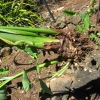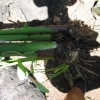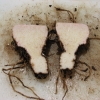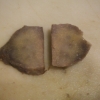Use As Food
Mainly as a table taro.
Distribution
Limited; grown primarily under upland, dryland culture (māla).
General Characteristics
Medium in height, well spreading, stocky, maturing within 9 to 12 months, producing from 5 to 10 ‘ohā; distinguished by its deep reddish-brown Hā (Petiole) and white kōhina (base).
Ha (Petiole)
65 to 80 cm, long, deep reddish-brown slightly diffused with green, purplish-red at top (apex), white at kōhina (base), with a narrow, dark pinkish lihi (stem edge).
Lau or Lu'au(Leaf Blade)
40 to 55 cm. long, 25 to 35 cm. wide, 30 to 45 cm. from tip to base of sinus (māwae), arrow head shaped, dark green with bluish cast; piko large, conspicuous, purple; veins distinctly purplish-red on lower surface, usually purplish on upper; round leaf section (lobes) acute with narrow lihi māhae (sinus or leaf cut).
'I'o kalo (Corm)
Flesh chalky white with yellow fibers; skin white to cream-colored.
Pua (Flower)
Remarks
The visible difference between Niue ‘Ula‘ula, No. 51, and Niue Uliuli, No. 61 is at the base of the Hā (Petiole). Niue ‘Ula‘ula, No. 51, is white at the kōhina (the base), while Niue Uliuli, No. 61, has a dark pink ring at the kōhina (base) with light pink for 3 to 4 cm. above the kōhina (base). According to a botanist named Erling Christophersen, Niue is apparently the name for a group comprising at least three varieties; the writers have not, however, been able to ascertain any characteristics by which the members of the group are linked.













